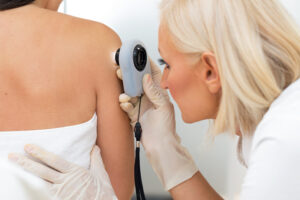May is Skin Cancer Awareness Month. Read on to find out what steps you can take to help prevent skin cancer.
May 2023
What are the different types of skin cancer?
The three main types of skin cancer are:
- basal cell carcinoma (BCCs)
- squamous cell carcinoma (SCCs)
- melanoma
BCCs and SCCs are different from melanoma – they are called non-melanoma skin cancers and are more common than melanoma.
Melanoma, also called malignant melanoma, is a cancer that usually starts in the skin.
What is the main cause of skin cancer and am I at risk?
The majority of skin cancers are caused by skin damage that happens from exposure to ultraviolet (UV) light from the sun. The damage can happen from sun exposure over a long period of time or from a history of getting sunburnt, but even people who have never experienced sunburn are still risk. Exposure to UV light from sunbeds and sun lamps also damage the skin and increase the risk of skin cancer.
People with a history of sunburn or overexposure to the sun as a child also have a greater risk of developing basal cell carcinoma, squamous cell carcinoma and melanoma. All types of skin are at risk of sun damage and skin cancer but fair-skinned people who tend to burn easily or go red or freckle in the sun are most at risk of developing skin cancer. Darker skin has a lower risk of developing skin cancer but there is still a risk. It is important for everyone to follow skin protection advice and to check their skin regularly, including areas that don’t get sun exposure.
What can I do to prevent skin cancer?
The best preventative is to cover up and be safe in the sun – wear a hat, long sleeved clothing and sunglasses. It is also important to check your skin regularly for any changes, and seek help if you do.
How can I be safe in the sun?
- Always use 5* UVA rated sun protection with a high SPF
- Stay hydrated
- Cover up with hat and long-sleeved clothes
- Wear UV blocking sunglasses to protect your eyes
- Don’t forget to apply sun cream to those easy to miss places – lips, tops of ears, back of neck, feet and scalp
- Limit your time in the sun and stay in the shade between 11am and 3pm
- Avoid letting your skin burn or go red
- Reapply skin protection every two hours
- Do not use a sunbed or sunlamp – use fake tan lotions or sprays instead

What are the symptoms of skin cancer?
Different types of skin cancer can vary in how they look. Skin cancer can appear anywhere on your body but is most likely to occur on skin that is exposed to the sun, such as the face and neck. Most commonly, non-melanoma skin cancer can appear as:
- smooth and pearly-white
- waxy
- a firm, red lump or may look sunken in the middle
- a pearly brown or black lump if you have darker skin
- a flat, red spot that is scaly and crusty a pale non-healing scar.
Look out for areas of skin that never completely heal, feel itchy and bleed sometimes, develop a crust or scab or develop into a painless ulcer.
Melanomas either start with a new, abnormal-looking mole in normal-looking skin. This usually looks like a dark area or a new mole that changes over weeks or months. Or they can develop from a mole that you already have. Using the ABCDE list below may help:
A is for asymmetrical – noncancerous moles are typically symmetrical. One half of a cancerous spot or mole may not match the other if you were to split the mole in half.
B is for border – the border of a cancerous spot or mole may be irregular or blurred, or it may be pink or red in colour.
C is for colour – a typical mole tends to be evenly colored, usually a single shade of brown. A cancerous mole may not be the same colour all over.
D is for Diameter – it may be a warning sign if it’s larger than 1/4 inch across (6 millimeters), which is about the size of a pencil eraser.
E is for evolving – moles that grow or change color or shape. They may also start to itch or bleed. Benign (noncancerous) spots and moles don’t usually change.
What should I do if I notice skin changes?
If you notice anything unusual on any area of your skin, make an appointment to get it checked by your GP as soon as possible. It might help to take a photograph of anything unusual, so you can check for any changes.
If you have darker skin, it can be harder to notice changes but if you notice any skin changes always see your GP. Make sure you check your skin all over, including the palms, soles of the feet or under the nails.
Our Consultant Dermatologists at Sussex Premier Health can offer a top to toe skin check to give you peace of mind. Complete our online enquiry form to find out more.
Further information
- Our Private GP would be happy to see if you if you have any changes in your moles. Find out more about our Private GP Service at Sussex Premier Health.
- Find out more about our Consultant Dermatologist, Dr Noor Alwash.
- Find out more about our Consultant Dermatologist, Dr Jan Von der Werth.